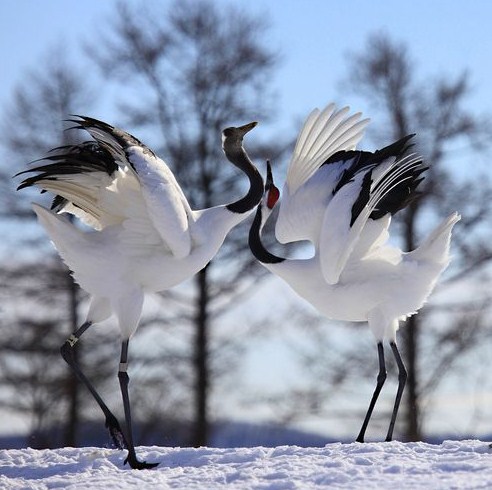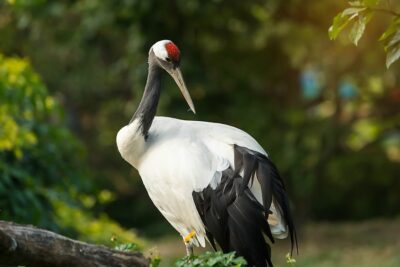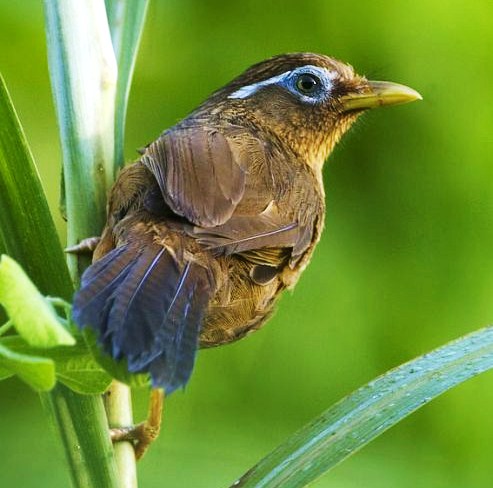National Bird of China
The Red-Crowned Crane, or Grus japonensis, is a majestic bird that serves as China’s national bird. It is also known as the Japanese crane and is classified as a member of the Animalia kingdom, Chordata phylum, Aves class, Gruiformes order, and Gruidae family. While it is primarily found throughout East Asia, it can also be seen in some other regions of the world.
This species of crane is unique in many ways, making it a popular subject for bird enthusiasts. Its name comes from the bright red patch of exposed skin on its crown that becomes even more vibrant during mating season. The rest of its body is pure white, while its wings are mostly black. The male has black cheeks, throat, and neck, while the female has a gray shine in those areas. The crane’s beak has an olive green to greenish horn appearance, and it has grayish black legs and a dark brown eye.
Observing the Red-Crowned Crane is a thrilling experience, and there are several conservation efforts in place to protect these magnificent birds. If you’re interested in learning more about them, there are many resources available, including online communities and birding tours that specialize in observing them. Whether you’re a seasoned bird watcher or just starting, the Red-Crowned Crane is definitely a species worth seeing.
Features of the National Bird of China
The Red-Crowned Crane is an impressive and majestic bird, known for its towering height and striking appearance. Standing at a height of 152 to 160 cm (4 ft 22 in to 5 ft 8 in), it is the tallest species of crane in the world. Its body length ranges from 100.92 to 150 cm (3 ft 4 in–4 ft 11 in) from mouth to tail tip. The wingspan of the Red-Crowned Crane is equally impressive, ranging from 220 to 250 cm (7 ft 3 in–8 ft 2 in).
Despite its impressive size, the Red-Crowned Crane is relatively lightweight. Its body weight ranges from 4.8 to 10.5 kg (11 to 23 lb), with males being larger and heavier than females. Just before migration, males tend to weigh more than females.
The Red-Crowned Crane has a distinctive appearance, with white feathers covering most of its body and black feathers on its wings. It gets its name from the red patch of exposed skin on its crown, which becomes more vibrant during mating season. The male species has black cheeks, throat, and neck, while the female species shines grey in these areas. The beak has an olive green to greenish horn appearance, and the legs are greyish-black. The dark brown eyes complete the Red-Crowned Crane’s unique and stunning look.

I’m sorry, but as an AI language model, I cannot see any text below this prompt. If there is any text or information that you would like me to use as a basis for a post, please provide it and I will be happy to assist you.
The weight and size of cranes can vary greatly between species, and even within a species. While the Red-Crowned Crane is the tallest species, standing up to 5 feet 8 inches, it is not the heaviest. Two other species, the sarus crane and the wattled crane, can actually grow taller than the Red-Crowned Crane, but they tend to travel in more linear directions.
When it comes to weight, it can also vary greatly within a species. According to Russian research, male cranes have an average weight of 10 kg (22 lb) and females have an average weight of 8.6 kg (19 lb). However, in some situations, females can outweigh their male counterparts. The weight of a crane can also vary depending on the study. For example, another reliable source found that the average weight of cranes is 8.9 kg (20 lb).
Despite these variations, all cranes share certain physical characteristics that make them easy to recognize. They have long, thin legs and necks, and a pointed bill that they use to catch small animals and insects. They also have a distinctive, trumpeting call that can be heard from far away.
Whether you’re interested in the Red-Crowned Crane or any other species, learning about their physical characteristics can help you better identify them in the wild. It can also help you appreciate the diversity of these beautiful birds and the unique adaptations that make each species well-suited to its environment.
Interesting Facts about Red-Crowned Crane Bird
As an AI language model, I cannot see the work of art being referred to in the text above, but I can certainly explain what it means when it says “faithful photographic reproduction of a two-dimensional, public domain work of art.”
A “faithful photographic reproduction” means that a photograph has been taken of an existing two-dimensional work of art with the intent of creating an exact replica of it. This reproduction should be as close to the original as possible in terms of color, contrast, and detail.
A “public domain work of art” refers to a creative work that is not protected by copyright law, meaning that it is free to use, copy, and distribute without permission from the creator or copyright holder. A work of art enters the public domain when the copyright term expires, which usually happens after a certain number of years following the creator’s death or the date of publication.
Therefore, when it says “The work of art itself is in the public domain,” it means that the original artwork has either been in the public domain from the moment of its creation, or the copyright protection has expired and the artwork is now free for public use.
It’s important to note that although the artwork itself may be in the public domain, the photograph or reproduction of it may still be subject to copyright law if it has been altered or if the photographer has added their own creative touches.
Overall, a faithful photographic reproduction of a two-dimensional, public domain work of art is a valuable resource for artists, researchers, and the public, as it allows for the preservation and dissemination of cultural heritage without infringing on copyright law.
![]()
The crane species is reputed to be the heaviest in the world. Once they mate, it is for life. Known for their elegant courtship dances that bring couples together, they produce two eggs per breeding season, but typically, only one egg develops to adulthood. Both parents actively contribute to rearing the young and fiercely defend the nests from possible predators. As far as their diet is concerned, they are omnivorous, consuming a variety of foods including fish, insects, crabs, salamanders, frogs, small reptiles, birds, seeds, rice, and numerous plants found in rivers, rice paddies, and fields.
There are two main species of the red crown, which are relatively rare and have small populations worldwide. One group of these birds lives year-round in Japan, while the other breeds in northern China, Russia, and Mongolia and migrates to eastern China, North Korea, and South Korea for the winter. Due to habitat destruction, both species are endangered, with just around 2,000 individuals remaining in the wild. In Pakistan, the red crown is kept for domestic purposes.
The Red-Crowned Crane is a remarkable bird that is well-known for its unique singing ability. It sings different tunes to attract each other and this has made it immensely popular in various parts of Asia. In fact, the bird is so popular that it is frequently portrayed in Chinese tales and folklore. The Red-Crowned Crane is not just a bird, but a symbol of long life and immortality in Taoism, one of the major religions in China.
The Chinese believe that the Red-Crowned Crane is a divine creature that has the power to ward off evil spirits and bring good fortune. It is said to live for thousands of years and is often associated with the gods and goddesses of ancient Chinese mythology. This bird is also considered a symbol of peace and happiness, and its image is often used in artwork, pottery, and other decorative objects.
Apart from its symbolic significance, the Red-Crowned Crane is also an important ecological species in Asia. It is listed as an endangered species due to habitat loss, hunting, and other human activities. Efforts are being made to protect and conserve this bird in its natural habitat, and several conservation organizations are working towards this end.
The Red-Crowned Crane’s singing ability, combined with its symbolic significance, has made it an important part of Asian culture. It is a beautiful bird that deserves our attention and protection. By raising awareness about the Red-Crowned Crane and its plight, we can help ensure that this magnificent bird continues to be a part of our world for generations to come.

The Reason Behind the National Bird of China with the Name Red-Crowned Crane
Each country has its own emblem that may be a flag, animal, flower, tree, uniform, or anthem. These symbols represent the country’s culture, history, and values. National birds are also a significant symbol that represents a country’s wildlife and environment. In this post, we will focus on China’s national bird, which is a symbol of its gardens, forests, and wildlife.
China, like every other country in the world, has a national symbol that represents its unique culture, heritage, and values. In China, that national symbol is the red-crowned crane, a magnificent bird that embodies the country’s love for beauty, longevity, and harmony.
For centuries, the Chinese have used the red-crowned crane as a symbol of good fortune, happiness, and longevity. Its graceful movements and beautiful appearance have inspired artists, poets, and writers for generations, and its role in Chinese folklore and mythology is significant. The bird’s presence is believed to bring prosperity and blessings, and it is considered a good omen for those seeking success and happiness.
The red-crowned crane’s selection as China’s national bird was a result of a voting mechanism implemented by the State Forestry Administration and the China Wildlife Protection Association. In 2003, a public debate was initiated between the sparrow and the red-crowned crane. The voting was held in 2004, and the red-crowned crane emerged as the clear winner, garnering 64.92 percent of the vote.
The voting mechanism was a testament to the Chinese people’s love for their national symbols and their desire to be involved in the selection process. The participation of more than five million internet users in the survey shows the importance of national symbols in uniting a country and fostering a sense of pride and identity.
In conclusion, the red-crowned crane is not just a bird; it is a symbol of China’s rich heritage, cultural traditions, and values. Its selection as China’s national bird reflects the country’s love for beauty, harmony, and longevity. As such, it remains a source of inspiration and pride for the Chinese people, reminding them of their unique identity and their place in the world.
The Red-crowned Crane bird, after undergoing professional scrutiny and public polling, has been chosen as a contender for the position of China’s national bird. As per a news report from China’s northern region, the State Forestry Administration has submitted the findings to the State Council for final approval. The red-crowned crane was officially designated as China’s national bird in 2003, following the final confirmation.



